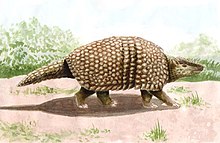Scirrotherium
| Scirrotherium | |
|---|---|

| |
| Life reconstruction of Scirrotherium | |
| Scientific classification | |
| Domain: | Eukaryota |
| Kingdom: | Animalia |
| Phylum: | Chordata |
| Class: | Mammalia |
| Order: | Cingulata |
| Family: | †Pampatheriidae |
| Genus: | †Scirrotherium Edmund & Theodor, 1997 |
| Type species | |
| †Scirrotherium hondaensis Edmund & Theodor, 1997
| |
| Species | |
| |
Scirrotherium is an extinct genus of pampatheres, a family of herbivorous cingulates, related to the similar but smaller modern armadillos, and with the now extinct glyptodonts, well-known from their shell-like armor. Its scientific name is derived from the Greek prefix "skiros-", "cover", and the suffix "-therion, "beast", while the name of the type species, hondaensis, honors the town of Honda, in the Tolima Department of Colombia.[1] Scirrotherium is one of several genera of xenarthrans found in the La Venta fauna, dated from the Middle Miocene.
Description
Scirrotherium is only known from an incomplete skull preserving teeth, a fragmentary mandible, postcranial vertebrae, and parts of its osteoderm armor. These remains were smaller than in its relative Kraglievichia, and larger than those of Vassallia.[1] Scirrotherium was characterized by its cylindrical molars, a bilobed eighth lower molar, and by the presence in the third thoracic vertebra of a disc-shaped surface, conjectured to have had a little mobility.[1] In Scirrotherium hondaensis, the mobile osteoderms presented in the sculpted area foramina aligned in two rows, with marked lateral edges, and a short, rounded and narrow axial elevation. The fixed osteoderms had fewer foramina arranged in the form of an arch with a posterior concavity and a narrower longitudinal central elevation, delimited by superficial longitudinal depressions.[2] Pampathere osteoderms attributed to this genus, from the Ituzaingó Formation in the Entre Ríos Province of Argentina, the Puerto Madryn Formation in the Valdes Peninsula in Argentine Patagonia and the Solimões Formation in the Brazilian State of Acre, under the species S. carinatum[3] have some anatomical differences with the type species, such as the anterior foramina of the mobile osteoderms arranged in a row and a longitudinal central elevation carinated.[2]
References
- ^ a b c G. Edmund and J. Theodor, 1997. A new giant pampatheriid armadillo. In: Kay RF, Madden RH, Cifelli RL, Flynn JJ, eds. Vertebrate paleontology in the Neotropics. The Miocene fauna of La Venta, Colombia, pp. 227–232. Washington, D.C: Smithsonian Institution Press.Engelmann, G.F.
- ^ a b Góis, Flávio; Scillato-Yané, Gustavo Juan. Nueva especie de Scirrotherium (Xenarthra, Cingulata, Pampatheriidae) del "Conglomerado osífero" (Mioceno tardío), base de la Formación Ituzaingó, provincia de Entre Ríos, Argentina. X Congreso Argentino de Paleontología y Bioestratigrafía-VII Congreso Latinoamericano de Paleontología. 2010
- ^ Flávio Góis, Gustavo Juan Scillato-Yané, Alfredo Armando Carlini and Edson Guilherme (2013). "A new species of Scirrotherium Edmund & Theodor, 1997 (Xenarthra, Cingulata, Pampatheriidae) from the late Miocene of South America". Alcheringa: An Australasian Journal of Palaeontology. 37 (2): 177–188. Bibcode:2013Alch...37..177G. doi:10.1080/03115518.2013.733510. hdl:11336/18791. S2CID 129039539.
{{cite journal}}: CS1 maint: multiple names: authors list (link)
- CS1 maint: multiple names: authors list
- Articles with short description
- Short description is different from Wikidata
- Articles with 'species' microformats
- Prehistoric cingulates
- Prehistoric placental genera
- Miocene xenarthrans
- Miocene genus first appearances
- Miocene mammals of South America
- Pliocene mammals of South America
- Pliocene xenarthrans
- Pliocene genus extinctions
- Neogene Argentina
- Fossils of Argentina
- Fossils of Brazil
- Neogene Brazil
- Neogene Colombia
- Fossils of Colombia
- Honda Group, Colombia
- Ituzaingó Formation
- Fossil taxa described in 1997


